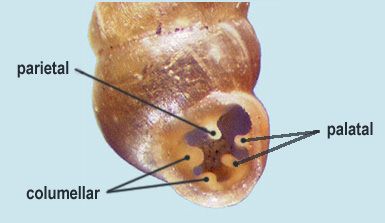Adaptation
Morphology:
Vertigo ovata, Say, 1822 is characterized by its dark
amber shell color, small size (approximately 2.2 mm long and 1.4
mm wide), and the presence of 5 whorls on its shell. The shell
has a particularly rounder, more egg-shape appearance than other
species of Vertigo, hence the species name ovata.
V. ovata has six teeth around its peristome. The teeth
are moderate in size compared to other Vertigo species
(Pilsbry, 1939-1948). These teeth are used for protection rather
than eating. See how V. ovata obtains
nutrition!
Protection:
Like other gastropods, V. ovata is protected from
predators by its shell. In the presence of danger, gastropods
can withdraw into their shells and seal the entrance with the
operculum, a tough plate located on the back of the muscular
foot (Gillis, 2011). V. ovata is also protected from predators by the
teeth around its peristome.
Although no species-specific information is known, several species of Vertigo are known to undergo a torpor sort of state when conditions are unfavorable. All Vertigo species require sufficient humidity to survive, so it is likely that in the presence of excessive heat or drought, V. ovata is minimally active as well (Killeen, 2003).
